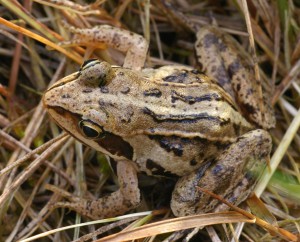Moor frog
 A common species to our fauna, it pertains to the group of brown frogs. In its upper parts it is brown or grayish, with dark spots and dots. It makes it barely visible in the grass, rotting foliage, pine needles, sticks and twigs in the spots it commonly inhabits. The throat of the moor frog is whitish, mainly marble-patterned. The belly is white or yellowish, and in most cases spot-free. In the spring, the males develop bright silvery-blue coloration – which is the nuptial dress – and their entire bodies become inflated and swollen. The basis of the foraging of this frog is composed of beetles. Beside beetles, they eat spiders, grasshoppers, bugs and caterpillars; in other areas, the foraging includes mosquitos with bugs losing their share, or bugs and mosquitos being replaced altogether by ants. The adults serve as food to lake frogs, water snakes, vipers, storks, glossy ibises, little bitterns, black-headed gulls, lesser spotted eagles, buzzards, crows and even wood grouses. These frogs were encountered in 56% of the studied badger stomachs; they are attacked by otters, minks, polecats, weasels, foxes, hedgehogs and even the more common shrews and moles. In the shells of the moor frog’s roe ranidine is contained – a special chemical fatal for protozoans. It is twice as strong as carbolic acid. Traditional medicine uses dried frog roe to treat erysipelatous inflammations.
A common species to our fauna, it pertains to the group of brown frogs. In its upper parts it is brown or grayish, with dark spots and dots. It makes it barely visible in the grass, rotting foliage, pine needles, sticks and twigs in the spots it commonly inhabits. The throat of the moor frog is whitish, mainly marble-patterned. The belly is white or yellowish, and in most cases spot-free. In the spring, the males develop bright silvery-blue coloration – which is the nuptial dress – and their entire bodies become inflated and swollen. The basis of the foraging of this frog is composed of beetles. Beside beetles, they eat spiders, grasshoppers, bugs and caterpillars; in other areas, the foraging includes mosquitos with bugs losing their share, or bugs and mosquitos being replaced altogether by ants. The adults serve as food to lake frogs, water snakes, vipers, storks, glossy ibises, little bitterns, black-headed gulls, lesser spotted eagles, buzzards, crows and even wood grouses. These frogs were encountered in 56% of the studied badger stomachs; they are attacked by otters, minks, polecats, weasels, foxes, hedgehogs and even the more common shrews and moles. In the shells of the moor frog’s roe ranidine is contained – a special chemical fatal for protozoans. It is twice as strong as carbolic acid. Traditional medicine uses dried frog roe to treat erysipelatous inflammations.
/ * The photos at lake.peipsi.org are cross-posted from commons.wikimedia.org and are used for familiarization purposes only. No commercial use of the photos is allowed. For more information about to use the photos see the originals on commons.wikimedia.org. /


